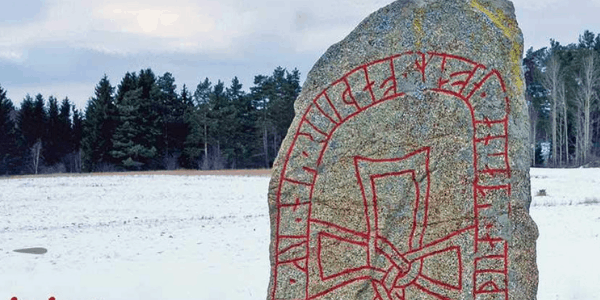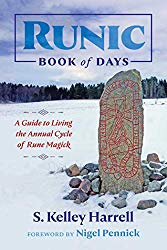
Runic Book of Days: A Guide to Living the Annual Cycle of Rune Magick, by S. Kelley Harrell
Destiny Books, 9781620557709, 208 pp., 2018
In their wonderful Heathen podcast Frithcast, hosts Suzanne Martin and Kate Coldwind offer the important admonition, “Nobody can tell you how to Heathen!” While this is absolutely true, and quite liberating, it can also leave the average Heathen a bit lost at times as they look about for guides as to how to incorporate their faith into their daily lives. One could forgive the fur-trimmed follower of Freyja for looking wistfully at the Catholic walking happily home from a bookshop with arms full of breviaries, missals, psalters, hymnals, a copy of the Malleus Maleficarum — whoops, that’s problematic, but never mind. The point is, whilst other faiths have a multiplicity of well established manuals, Heathenism tends to fall strongly on the DIY side.
Enter S. Kelley Harrell with Runic Book of Days: A Guide to Living the Annual Cycle of Runic Magick, a refreshingly sincere and thoughtful option for the Heathen (or those more generally interested in the runes of the Elder Futhark) to use the ideas and images raised by the runes, combined with a seasonally oriented calendar, to structure a series of daily devotions in order to deepen spiritual thought and practice. That’s rather a lot to pack into one sentence, so let’s try to break this down further!
First, the runes themselves. Harrell focuses on the runes of the Elder Futhark, which is the most commonly explored rune system. (For a breakdown of this and other runic alphabets, I strongly recommend Runes: The Icelandic Book of Futhark, by Teresa Drofn Freysdottir Njardvik.)1 Harrell offers an excellent introduction to the Elder Futhark, exploring the symbolic associations with each rune in detail. Because she advocates the use of runes for divination, she provides both upright and reversed (brightstave and merkstave) interpretations where possible — some runes have no reverse position. Harrell’s interpretations reveal a great deal of careful thought on the runes, not only as they stand alone, but also how they follow each other and reinforce certain ideas within each grouping (aett).
Secondly, in Runic Book of DaysHarrell presents a runic calendar which is based on the work of previous scholars. As she explains:
The basis of what is accepted now as the runic calendar stems from a distillation of…earlier calendars and lines in the Voluspa and Havamal poems. Rune scholar Freya Aswynn postulated that the Nine Worlds correlated with the nine runes that can’t be reversed, and the twelve palaces of the Grimnismal with the twelve contemporary zodiac signs. With these associations author Nigel Pennick later deconstructed various seasonal cycles of Germanic, Anglo, and Celtic traditions of northern Europe, honored their overlaps with each other and the runes, and set the calendar’s base structure of timekeeping according to the Elder Futhark.2
At this point, the reader has a choice. It’s quite possible to say, “Brilliant! What a wonderfully creative and esoteric approach to a seasonal framework!” Another possible response is, “What a bunch of hogwash! This is exactly why I despise New Age salmagundi approaches that treat everything as equivalent and interchangeable!” I tend to favour a middle approach, and say, “I’m not at all sure about your methodology, but since nobody can tell me how to Heathen, I’m going to see what you have to offer and whether it works for me.”
Credit to Harrell — what she has to offer in Runic Book of Days is very interesting. There are 24 runes in the Elder Futhark, and she uses a calendar of 24 “half-months,” which include eight holy days that should be familiar to most Pagans (Samhain, Imbolc, Yule, etc), with a rune associated with each of these “fortnight” periods. Within each of these periods, she offers a series of devotions, affirmations, and possible initiations associated with each rune. The idea is to structure a certain kind of worship in harmony with the seasons, taking the time to explore the symbolic associations of each rune in detail and deepening an overall understanding of the runes individually and collectively.
For someone like me who is looking for greater structure and shape to my religious practice, it’s quite attractive. I can’t yet speak to its seasonal efficacy (although I will be trying the devotions and affirmations over the course of the next year), but I will say that I find her interpretation of the runes to be thought-provoking and indicative of someone who has given them a great deal of thought over a substantial period of time.
Anarchic liberty can be intoxicating (ask a Lokean), but I like to find my balance with some sense of structure, and that is precisely what S. Kelley Harrell provides in the Runic Book of Days. Although the construction of her calendar is a work of amalgamation rather than reconstruction, what she’s done with it is a labour of love, and it shows. I look forward to trying it out myself.
- See John Farrell’s review of Runes: The Icelandic Book of Futhark, by Teresa Drofn Freysdottir Njardvik. [↩]
- p. 70-71 [↩]









